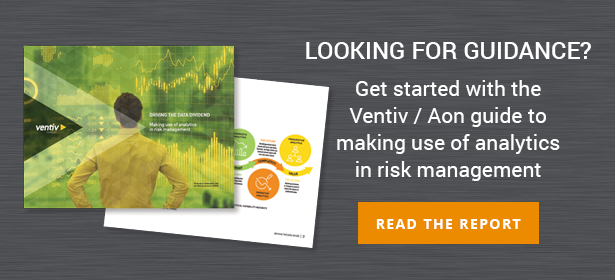Let’s talk about big data. It’s a hot topic in the world of risk management, and the world as a whole. But what is it? What makes it ‘big’? And, what can you do with it?
Gartner first defined ‘big data’ in around 2001 with the ‘three Vs’ – volume, velocity and variety.
Today, their definition takes this one step further describing it as “high-volume, high-velocity and/or high-variety information assets that demand cost-effective, innovative forms of information processing that enable enhanced insight, decision making, and process automation”.
There is not a specific size as to when a data set is classed as ‘big’; however, with the increasing speed at which we are creating and storing data, it would be fair to say that we are looking at a minimum of terabytes of data—and potentially as big as zettabytes (a billion terabytes).
Traditional data
Taking a step back, businesses would traditionally use structured information that could be sorted and managed in a relational database, such as a CRM (customer relationship management) system, to make decisions. Mainly because these were the only datasets that they could make use of.
Due to the requirements of needing to fit into set fields and the cost of storage, the amount of information was relatively small, and contained. Needless to say, it didn’t mean that the accuracy of it could be guaranteed, as we all know how hard it is to collate information manually.
However, there was still a plethora of unstructured information—a goldmine of insight into customers, competitors, industry and the global landscape.
This is big data. It is the larger, more complex information that on first appearance won’t fit into traditional databases or appears unmanageable. In Ventiv’s joint report with Airmic, we consider the three Vs of big data and explain them further:
- Volume: Data that is large in quantity and from multiple sources, including internally and externally collected data
- Variety: Different types of data, including structured (organised and categorised), and unstructured (unorganised) data
- Velocity: Information that is gathered at greater speed than traditional data sets.
(Airmic 2017: Driving the data dividend. Making use of analytics in risk management. P5)
When harnessed and structured properly, these sets can provide invaluable insight for business.
Taking big data that one step further
The wider industry has built on the three Vs model as we begin to better understand how we can use big data. Oracle talks about the ‘value’ and ‘veracity’—or the accuracy—of your data. ‘Variability’ has also been suggested.
At Ventiv, we wholeheartedly believe in the importance of the veracity of data. Without accurate information, you simply cannot make important business decisions that you are confident in.
Human error is often the cause of poor data. Data capture tools, such as Ventiv Digital, help to remove this issue and put some structure into potentially big data sets.
Where might you find big data?
There are huge amounts of complex and unstructured data available all around us. Some sources include:
- Customer feedback
- Social media
- Marketing analysis
- User behaviour data
- Government-generated data (e.g., census and other socioeconomic data)
Big Data: The challenge
Businesses cannot immediately start using ‘big data’ to identify relationships and trends. Time and resource must be invested into linking the multiple sets of data collected across separate areas of the business, and for separate purposes. (Airmic 2017: P5).
This is where it’s vital to link an organisation’s risk management software solution with an advanced analytics system. Data can be stored in a so-called “data lake” and tagged to make interrogation much easier. Once the data is in a manageable format, you can use advanced analytics to draw out reports and provide actionable insights.
The Ventiv risk management analytics software cloud is designed to do just this: it allows risk, insurance and claims managers to combine and explore multiple data types such as claims, exposure, property type and any third-party data, enabling them to uncover correlations and draw insights into their business that might otherwise remain hidden.
Ventiv already offers multiple prebuilt data sets specific to risk, insurance, and claims management, including historical earthquake, wildfire, weather, and census data. However, clients can now easily add third-party data (including data from TPAs, insurers, and consultants providing industry benchmarking information) to their Ventiv Analytics Cloud for enhanced data exploration.
According to the 2017 Airmic report, more than a third of risk managers (35%) said that their use of analytics tools was limited, but within three years, more than half of risk managers (56%) expect to be using data analytics extensively in their roles.
Three years brings us to 2020, which means that we are potentially now moving into an era of huge opportunity for businesses who can start seeing the fruits of their hard work in structuring and managing their big data.
David Thomas is the Sales Director at Ventiv Technology. If you would like any further information on this topic please contact him at DAVID.THOMAS@VENTIVTECH.COM














